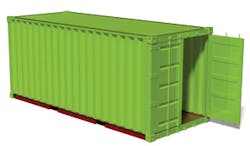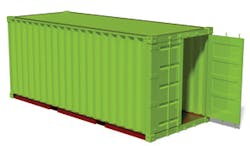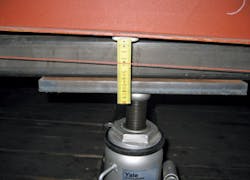Laser processing steel floors for containers
Structural and wear-resistant steels are used
Jukka Siltanen, Ilpo Maaranen, and Ville-Matti Nurmela
More Industrial Laser Solutions Articles |
Laser welding in commercial furniture manufacturing Laser-GMA hybrid joining of thick high-strength steels |
Finnish steel-maker Ruukki Metals is focused specifically on the manufacturing of special steels such as high-strength, wear-resistant, and protective steels. Steel flooring innovation for marine containers connects the use of special steels and laser processing in a unique way. The steel flooring has many advantages compared to traditional marine plywood-based flooring. Steel flooring is an environmentally friendly alternative with several benefits: it is 100% recyclable, it has a long lifetime, and it offers uniform quality.
A new type of floor structure for marine containers utilizes both the excellent properties of wear-resistant and high-strength steels and the advantages of high-power CO2 laser welding. Wear-resistant steel is protected against wear and impacts. High-strength steel can carry heavy loads even with small material thicknesses. Laser welding as a low heat input welding method causes only minor distortions and a high welding speed is possible.
Marine transportation overview
Currently, the manufacture of marine dry-cargo containers takes place primarily in Asia, more precisely in China, mainly because the manufacturing of containers can be done close to the end user to avoid the unnecessary transportation of empty containers.
The structure of a dry-cargo container has remained almost constant from the late 1950s (see FIG. 1). The floor structure of the container includes cross-members made of steel beams that are covered by plywood sheets. Screwing affixes a plywood sheet to steel beams, making it a time-consuming process, for example, the floor of a 20 ft container can include more than 200 countersunk screws. The steel used for the under parts of the floor is a weather-resistant steel like Cor-Ten. The same steel is also used for the walls and roof of the marine container. The profiles of the walls and roof are normally corrugated to add stiffness to the structure. During its lifetime, a dry container encounters very different conditions, so special consideration must be paid to the surface treatment and especially to protection against corrosion.
Over the past years, major efforts have been made to find a substitute material for plywood. Woods such as larch, birch, and bamboo, and even plastic, have been tested as container floor materials. A few containers with steel flooring have also been manufactured. Simplifying this has been done by replacing the plywood sheets with steel plates. The average repair costs for steel floors was around 80% less than the average for regular plywood floor containers. The structure itself has worked very well, but the issues are weight, sometimes the inability to nail, and higher manufacturing cost.
Based on these facts, a totally new material or structure to challenge or even beat the use of plywood does not exist. The flooring often takes a heavy load so the flooring material must be strong enough to carry a load as much as 30 tons, and forklifts as well, which are used to run cargo inside the container. The new innovation, a laser-welded sandwich steel floor, fulfills most requirements set for the floor structure: it is very stiff, light, and can handle hefty loads. The structure merges the benefits of the laser-welded sandwich panel and the excellent mechanical properties of wear-resistant and high-strength steels.
Producing the steel floor
Ruukki Metals’ steel service center in Uusikaupunki specializes in processes such as laser cutting and laser welding. Welding operations are certified according to standards ISO 3834 (welding procedures), EN 15085 (welding of railway vehicles and components), and EN 1090 (steel construction).
The steels used for the open sandwich steel floor include the high-strength structural steel (Optim) and the wear-resistant hardened steel (Raex). The structural steel is used for the cores, side, and end profiles, and wear-resistant steel is used for the top plate. V-shape cores with an optimized opening angle are used in the structure. The cores and all profiles for the prototypes are bent by a bending machine to achieve high accuracy for the parts. Detailed information about steels manufactured by Ruukki is available on our website (www.ruukki.com). In addition, the site contains valuable information on the use of special steels in demanding applications.
The slightly simplified manufacturing process for the open sandwich steel floor includes the following work stages:
- Two cut-to-length strip steel plates (wear-resistant steel) are laser welded together by a laser butt joint to achieve a large top plate for the steel floor.
- V-shape cores (structural steel) are laser welded by a lap joint to the top plate.
- The side and end profiles (structural steel) are manually welded by GMAW to the floor.
- Finally, the floor is joined by manual welding to the frame of the used 20 ft marine container.
Some of the key laser-welding parameters are presented in TABLE 1 and the ready-to-assemble floor is presented in FIGURE 2.
Testing of the steel floor
Standard ISO/TR 15070 lays down the basic specifications, testing requirements for freight containers, and some updated information about the tests, such as current values of the loads and the forces used in testing. The testing procedure according to standard ISO/TR 15070 contains the following tests for structural examination of containers. The tests for which the structure of the floor has some effect were selected (marked with italics on the list) for the testing procedure for the steel floor containers:
1. Stacking test; 2. Lifting from the four top corner fittings; 3. Lifting from the four bottom corner fittings; 4. Longitudinal external restraint; 5. Strength of end walls; 6. Strength of side walls; 7. Roof strength; 8. Floor strength; 9. Rigidity (transverse; 10. Rigidity (longitudinal); 11. Lifting from fork-lift pockets.
The testing started with the demanding floor strength test. The verbal acceptance criteria for every test, described in the standards, is relatively easy to understand: Upon completion of the test, the container shall show neither permanent deformation which will render it unsuitable for use nor abnormality which will render it unsuitable for use, and the dimensional requirements affecting handling, securing and interchange shall be satisfied.
Standard ISO/TR 15070 also defines the exact acceptance limits in millimeters for some of the main parts of the container in each test. The accepted deformation after the complete testing procedure is defined in the standard, and no part of the base of the container shall deform more than 6 mm below the floor base plane. The standard contains the formulas for calculating the loads and the forces used for qualification tests, and those varied from test to test. Unfortunately, it is not possible to present the complete test report in the article, but all tests were passed without any remarks. TABLE 2 presents the values of deformation after the complete testing procedure measured from seven places in the container. The simple measuring device for the deformation is depicted in FIGURE 3.
Summary
The test results for the new steel floor are promising. The weight of the laser-welded steel floor is just a few percent higher than the weight of traditional plywood-based floor structures. Further actions are needed to find the best protection method and coating for the flooring. A big challenge will be developing a cost-effective manufacturing process to beat and improve on the current manufacturing process for plywood-based flooring. Nevertheless, the business potential for the manufacture of dry-cargo containers is huge. The yearly need for new containers is in the millions, and we have found that the end users of the containers are open-minded and support the efforts to find substitute materials for the flooring of containers. ✺
Jukka Siltanen is project manager for Ruukki Metals Oy, Hämeenlinna, Finland, and Ilpo Maaranenis is plant director and Ville-Matti Nurmela is operations manager at Ruukki Metals Oy, Uusikaupunki, Finland.
More Industrial Laser Solutions Current Issue Articles
More Industrial Laser Solutions Archives Issue Articles




